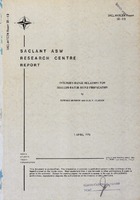| dc.contributor.author | Murphy, Edward | |
| dc.contributor.author | Olesen, Ole V. | |
| dc.date.accessioned | 2018-10-11T14:06:30Z | |
| dc.date.available | 2018-10-11T14:06:30Z | |
| dc.date.issued | 1976/04 | |
| dc.identifier | 1792 | |
| dc.identifier.govdoc | SR-12 | |
| dc.identifier.uri | http://hdl.handle.net/20.500.12489/253 | |
| dc.description.abstract | Convincing experimental evidence is presented to show that various "decay laws" for the decrease of sound intensity with increasing range can give high-quality representation for shallow water data. However, while a sequence of decay laws may fit data well and are simple, the transition ranges for changeover from one law to another can show a complicated dependence on frequency and environmental parameters. Transition ranges are probably no easier to predict or model than is the transmission loss itself. | |
| dc.format | 6 p. : ill. | |
| dc.language | English | |
| dc.publisher | NATO. SACLANTCEN | |
| dc.relation.ispartofseries | ADA075638 | |
| dc.source | In: Journal of the Acoustical Society of America, vol. 59, no. 2, February 1976, pp. 305-311. | |
| dc.subject | Acoustic propagation | |
| dc.subject | Shallow water | |
| dc.subject | Transmission loss measurements | |
| dc.subject | Elba Island | |
| dc.title | Intensity-range relations for shallow-water sound propagation | |
| dc.type | Papers and Articles | |
| dc.type | Scientific Report (SR) | |
